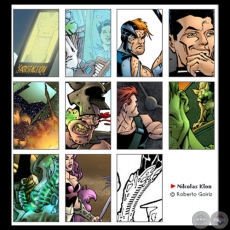Roberto Goiriz


NIKOLAS KLON © Roberto Goiriz


NIKOLAS KLON
© Roberto Goiriz
Â
The action is developed in the near future. The humanity has been organized in corporations and companies and it has abandoned the political organizations. The countries have siest to exist or they are declining. The clonation of humans is permitted, with limitations. Depending on the corporation in which they works, and their range, each citizen has the right to a given quantity of clones. They are used as committee banks. They also have other functions, such as will be seen.
A prices war explodes among two gigantic corporations. Each one calls to the citizens that integrate the enrollment. The greater range citizens do not need be enlisted, they can send their clones.
Nikolas is a first citizen. And rejects fighting. He wants one os his clones to replace him, but can´t.
A clon of NiKolas is enlisted to the war. Quickly it is underlined by their abilities -and by their luck to be maintained alive.
In one of the battles among corporations, Nikolas procures the point of material sewer computer information which can decide the outcome of the fight.
A hallucinater lives in a places where virtually all waste materials of the corporatives wind up.
The sewer is governed by the master programmer, that send successive assaults and freak waves against Nikolas. Nikolas fights to survive. Then the programmer sends a beautiful woman. Nikolas it is not trained to face. But before Nikolas is yielded, and perhaps by dread of the consequences of the clone and the machines, the same master programmer appears and stopped Nikolas, proposes a truce.
The programmer proposes intervene in the price wars, creating a similar tariff for both, in exchange forNikolas abandons the sewer and leaves it alone. Nikolas accepts.
The war ends, since all the prices are the same (though nobody knows why). Each corporation is awarded the victory.
Nikolas ends being a hero of the corporation. But not the clone, the original. The clone is relegated to custody service, protecting his original.
The citizen Nikolas enjoys his hero privileges, perhaps too much. Dies due to a overdose of drugs, women and alcohol.
There is a rule in the corporations. When an original dies, all their clones should be eliminated.
This order is imparted. Because there is something that the corporation aid not count on.
Nikolas Klon wants to live.
ROBERTO GOIRIZ
NacĂ en AsunciĂłn, Paraguay, en 1961. IniciĂ© mis tareas profesionales en el diario ABC Color, en 1977, dibujando para el suplemento escolar y publicando mis primeros dibujos de humor gráfico. En 1978, ganĂ© el segundo puesto del Primer Concurso Nacional del Humor Gráfico, organizado por el diario La Tribuna. TrabajĂ© en ese medio, publicando dibujos e historietas; y posteriormente me trasladĂ© al ámbito publicitario, como diseñador gráfico. Paralelamente, empecĂ© a exponer, en forma conjunta con amigos artistas, en varias galerĂas de arte y centros culturales de AsunciĂłn, y luego en forma individual. En 1980 creĂ©, en conjunto con ArgĂĽello y Moreno, la primera revista de historietas del Paraguay: Quimera. En 1983 retornĂ© al medio periodĂstico, trabajando en el Diario Ultima Hora, donde desarrollĂ© propuestas de humor e ilustraciones, e hice nacer a Jopo, quizá uno de mis personajes de comics más conocidos en Paraguay. TambiĂ©n creĂ©, en conjunto con Moreno y Nico, la revista El Raudal, un canal de expresiĂłn underground que congregaba la producciĂłn nacional en el gĂ©nero, y donde se escapaba a la censura y autocensura de la Ă©poca. En el año 1986 me trasladĂ© a Sao Paulo, Brasil, para colaborar con la editora Press, y trabajar tambiĂ©n en el estudio del historietista Ely Barbosa, que publicaba sus personajes en revistas de la editora Abril. RegresĂ© al paĂs en el año 1989, y volvĂ al ámbito publicitario, trabajando para agencias como Biedermann/Ogilvy & Mather (director de arte), Mass/Leo Burnett (director creativo) y Bilbao/Young & Rubicam (director creativo), ganando premios a la creatividad en el paĂs y el exterior.
Paralelamente seguĂ desarrollando propuestas en el campo de los cĂłmics, con el sello de la editorial El Lector; y participĂ© en la creaciĂłn de la carrera de Diseño Gráfico de la Universidad CatĂłlica de AsunciĂłn, donde enseño hasta hoy. TambiĂ©n enseño en el área de ComunicaciĂłn, de Ciencias de la ComunicaciĂłn. Actualmente, dirijo la agencia de publicidad Goiriz Imagen & CĂa. S. A. y continĂşo con mis emprendimientos en el campo del cĂłmic. Con Guiones de Robin Wood, dibujĂ© "Isabella, historia de un fantasma", publicada en diversos medios paraguayos, y estoy colaborando con varias editoras norteamericanas, dibujando historietas para ese mercado.
Fuente en Internet: www. goiriz.com (On Line en Febrero 2013)

Humor Gráfico. Por Roberto Goiriz






Todos los derechos reservados
Desde el Paraguay para el Mundo!
Acerca de PortalGuarani.com | Centro de Contacto
